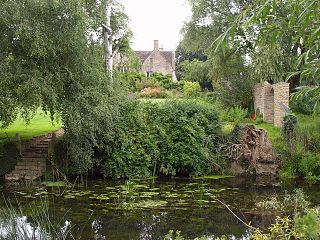St Neots Priory was a Benedictine monastery beside the town of St Neots in the historic county of Huntingdonshire,now a non-metropolitan district in the English county of Cambridgeshire.

Monkton Farleigh is a village and civil parish in west Wiltshire, England, on high ground 3 miles (5 km) northwest of Bradford-on-Avon, and a similar distance east of the city of Bath. The parish includes the hamlets of Farleigh Wick and Pinckney Green. In the west and northwest the parish is bounded by Somerset.

Edington Priory in Wiltshire, England, was founded by William Edington, the bishop of Winchester, in 1351 in his home village of Edington, about 3 3⁄4 miles (6 km) east of the town of Westbury. The priory church was consecrated in 1361 and continues in use as the parish church of Saint Mary, Saint Katharine and All Saints.

Ogbourne St George is a village and civil parish on the River Og about 3 miles (4.8 km) north of Marlborough, Wiltshire, England.

Ogbourne St Andrew is a civil parish and small village in Wiltshire, England, 2 miles (3.2 km) north of Marlborough. The parish is on the banks of the River Og and includes the hamlets of Ogbourne Maizey and Rockley.

Kington St Michael is a village and civil parish about 3 miles (4.8 km) north of Chippenham in Wiltshire, England.
Amesbury Abbey was a Benedictine abbey of women at Amesbury in Wiltshire, England, founded by Queen Ælfthryth in about the year 979 on what may have been the site of an earlier monastery. That foundation was dissolved in 1177 by Henry II, who founded in its place a house of the Order of Fontevraud, known as Amesbury Priory.

Monkton House in Broughton Gifford, Wiltshire, England is a Grade II* listed 16th-century house.

Monkton Farleigh Manor is a Grade I listed country house close to the village of Monkton Farleigh in Wiltshire, England. Built on the site of a Cluniac priory founded in 1125, the house is about 3 miles (5 km) northwest of Bradford-on-Avon and 4 miles (6 km) east of the city of Bath.

Ogbourne Maizey is a hamlet in Wiltshire, England 1.6 miles (2.6 km) north of the town of Marlborough and 0.4 miles (0.64 km) south of the village of Ogbourne St. Andrew.

Cottisford is a village and civil parish in Oxfordshire, about 3.5 miles (5.6 km) south of Brackley in neighbouring Northamptonshire. The parish's northern and northwestern boundaries form part of the boundary between the two counties. The parish includes the hamlet of Juniper Hill about 1 mile (1.6 km) northwest of Cottisford. The 2011 Census recorded the parish's population as 216.

Goldcliff Priory was a Benedictine monastery in Goldcliff, Newport, South Wales, founded in 1113 by Robert de Chandos and subject to the Abbey of Bec in Normandy. The priory was situated on the site now occupied by Hill Farm, to the south of the current farmhouse, on the prominent knoll of high ground next to the sea. As late as the 1950s Hando remarked that outlines of buildings which were probably part of the priory could still be seen in grass patterns or crop marks at certain times of the year. By the 1970s the only remaining physical remnant of the priory was to be found as part of a cellar in the farm house.
Grovebury Priory, also known as La Grave or Grava was a priory in Leighton Buzzard, Bedfordshire, England. It was established in 1164 and disestablished in 1414.
Povington Priory was a Benedictine priory in Tyneham, Dorset, England.
Ruislip Priory was a priory in Middlesex, England. In 1086 or 1087 the manor of Ruislip was given to Bec Abbey by Ernulf de Hesdin. An administrative centre, it had a priory before 1200. In the early 13th century the administration of Bec's manors was shared with Ogbourne Priory in Wiltshire. As one of the alien priories, Ruislip shared their varying fortunes. Ruislip was always a manor-house rather than having conventual buildings. After 1404 the manors were reallocated, Ruislip going to St Nicolas College, Cambridge. St Nicolas College was later renamed King's College.
Blakenham Priory was an estate in monastic ownership in the late Middle Ages, located at Great Blakenham in Suffolk, England.
The Priory of St Mary Magdalene was a Cluniac priory in Monkton Farleigh, Wiltshire, England, in the 12th to 16th centuries.

Upavon Priory was a small priory in Wiltshire, England.
Stoke-by-Clare Priory was a Benedictine monastery in Stoke-by-Clare, in Suffolk, an alien priory, dependent on Bec Abbey, in Normandy. Reinstituted in 1124, the Priory was suppressed in 1415.










